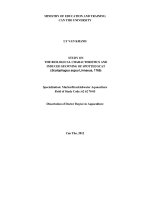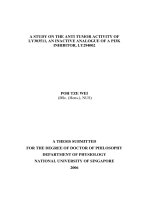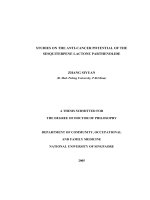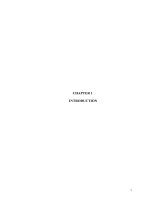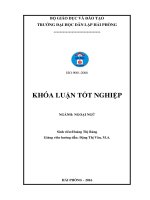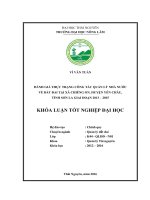Study on the anti oxidation and anti cancer of arthrospira platensiss extraction (khóa luận tốt nghiệp)
Bạn đang xem bản rút gọn của tài liệu. Xem và tải ngay bản đầy đủ của tài liệu tại đây (1.29 MB, 57 trang )
VIETNAM NATIONAL UNIVERSITY OF AGRICULTURE
FACULTY OF BIOTECHNOLOGY
~~~~~***~~~~~
GRADUATION THESIS
STUDY ON THE ANTI-OXIDATION AND ANTICANCER OF ARTHROSPIRA PLATENSIS’S
EXTRACTION
Student
:
TRAN NGOC DANG
Student code
:
610600
Class
:
K61CNSHE
Supervisor
:
PHI THI CAM MIEN, Ph.D
HANOI - 2021
STATUTORY DECLARATION
I herewith formally declare that I have written the summited thesis
independently under the guidance of Phi Thi Cam Mien, Ph.D Faculty of
Biotechnology, Vietnam National University of Agriculture. Data and results
written in the essay completely truthful. I did not use any outside support except
for the quoted literature and other sources mentioned at the end of this thesis.
Hanoi, 5th February 2021
Student
Tran Ngoc Dang
i
ACKNOWLEDGEMENT
First and foremost, I would like to express my sincere thanks to my
supervisor, Phi Thi Cam Mien, Ph.D, Faculty of Biotechnology, of the Vietnam
National University of Agriculture who enthusiastically guided and helped me in
the process of practicing and implementing the thesis.
I would like to thank the teachers of the Institute of Biotechnology and
Institute for Research and Development of Microalgae of the Vietnam National
University of Agriculture for creating favorable conditions to allow me to
conduct experiments related to my graduation thesis.
I also would like thanks to Associate Professor Nguyen Duc Bach, Ms.
Hien, and all interns at the Institute for Research and Development of
Microalgae for helping me in the research process here.
Last but no mean least, I would like to acknowledge my parents for their
endless love, care and have most assistance and motivation for me for the whole
of my life. I also would like to explain my thanks to my siblings, brothers and
sisters for their support and care for me all the time.
Hanoi, 5th February 2021
Student
Tran Ngoc Dang
ii
TABLE OF CONTENTS
STATUTORY DECLARATION ....................................................................................i
ACKNOWLEDGEMENT ............................................................................................. ii
TABLE OF CONTENTS .............................................................................................. iii
LIST OF TABLES ...........................................................................................................v
LIST OF FIGURES....................................................................................................... vii
LIST OF ABBREVIATIONS ..................................................................................... viii
ABSTRACT.....................................................................................................................ix
CHAPTER I. INTRODUCTION ....................................................................................1
1.1. Introduction .................................................................................................... 1
1.2. Objective ........................................................................................................ 1
1.3. Requirements .................................................................................................. 1
CHAPTER II. LITERATURE REVIEW .......................................................................2
2.1. Introduction in Arthrospira platensis ............................................................. 2
2.2. Taxonomy of Arthrospira platensis ............................................................... 3
2.3. Morphology of Arthrospira platensis ............................................................ 4
2.4. Distributions of Arthrospira platensis ........................................................... 4
2.5. Biochemical composition of Arthrospira platensis ....................................... 5
2.6. Application of Arthrospira platensis .............................................................. 8
2.7. Methods of plant extraction. ........................................................................ 13
2.7.1. Soxhlet extraction method......................................................................... 13
2.7.2. Steam distillation method .......................................................................... 14
2.8. Methods of assessing the antioxidant capacity of plant extracts ................. 15
2.8.1. DPPH method ............................................................................................ 15
2.8.2. MDA method............................................................................................. 16
2.8.3. ABTS˙+ method ......................................................................................... 17
iii
2.9. Some methods of assessing the ability of plant extracts to inhibit cancer
cell growth ............................................................................................... 17
2.9.1.MTT method .............................................................................................. 17
2.9.2. Monks method ........................................................................................... 18
2.9.3. WST-8 method .......................................................................................... 18
2.10. The Arthrospira platensis studies in Vietnam and in the world ................. 19
2.10.1. In Vietnam ............................................................................................... 19
2.10.2. In the world ............................................................................................. 20
CHAPTER III. MATERIALS, CONTENT AND METHOD OF RESEARCH ......22
3.1. Material, place and time of the study. ....................................................... 22
3.1.1. Material ..................................................................................................... 22
3.1.3. Location and time of study ........................................................................ 23
3.2. The research contents ................................................................................... 23
3.3. The Research Methods ................................................................................. 23
3.3.1. Sample preparation method....................................................................... 23
3.3.2. The extraction method with Soxhlet to obtain extracts ............................ 23
3.3.3. Evaluate the antioxidant ability of microalgae extracts by the DPPH
method ..................................................................................................... 24
3.3.4. Evaluate the antioxidant ability of microalgae extracts by the MDA
method ..................................................................................................... 24
3.3.5. Evaluate the anti-cancer ability of microalgae extracts by MTT
method ..................................................................................................... 25
CHAPTER IV. RESULTS AND DISCUSSION ........................................................28
4.1. Evaluate the effect of sample state on microalgae extraction efficiency ..... 28
4.2. Evaluate the effect of solvent type on microalgae extraction efficiency ..... 28
4.3. Evaluate the antioxidant ability of microalgae extracts by the DPPH
method ..................................................................................................... 31
iv
4.4. Evaluate the antioxidant ability of microalgae extracts by the MDA
method ..................................................................................................... 35
4.5. Evaluate the anti-cancer ability of microalgae extracts by MTT method.... 38
CHAPTER V. CONCLUSION AND SUGGESTION ...............................................42
5.1 Conclusion ..................................................................................................... 42
5.2. Request ......................................................................................................... 42
REFERENCES ...............................................................................................................44
v
LIST OF TABLES
Table 2.1. Arthrospira platensis scientific classification ...............................................3
Table 2.2. Amino acid composition in Arthrospira platensis........................................5
Table 2.3. Vitamin composition in Arthrospira platensis..............................................6
Table 2.4. The fatty acid composition in Arthrospira platensis ....................................6
Table 2.5. Mineral composition in Arthrospira platensis ..............................................7
Table 2.6. Pigmentation composition in Arthrospira platensis .....................................8
Table 4.1. The effect of sample state on microalgae extraction efficiency .................28
Table 4.2. The effect of solvent type on microalgae extraction efficiency .................29
Table 4.3. Antioxidant activity of extracts in the test by DPPH method ....................32
Table 4.4. The EC50 value of types of extracts in the DPPH test ................................33
Table 4. 5. The MDA antioxidant activity of studied samples ....................................35
Table 4.6. The cytotoxicity of the sample on cell lines ................................................39
vi
LIST OF FIGURES
Figure 2.1. Arthrospira platensis powder ............................................................. 4
Figure 2.2. Soxhlet extractor ............................................................................... 14
Figure 2.3. Steam distillation apparatus .............................................................. 15
Figure 2.4. DPPH chemical ................................................................................. 16
Figure 2.5. A spectrometer .................................................................................. 17
Figure 3.1. Human hepatocellular carcinom cells (HepG2 cells) ....................... 27
Figure 3.2. Human breast carcinoma cells (MCF-7 cells) .................................. 27
Figure 4.1. Extraction of Arthrospira platensis by Soxhlet extractor ................ 30
Figure 4.2. Extracts of Arthrospira platensis ...................................................... 30
Figure 4.3. Arthrospira platensis extract ............................................................ 31
Figure 4.4. The correlation of concentration and% of antioxidant activity of
extracts .................................................................................................... 33
Figure 4.5. Image of color change of sample in DPPH test ................................ 34
Figure 4.6. Experimental plates of three samples extract and control in MDA
inhibitory reaction ................................................................................... 37
Figure 4.7. The correlation between concentration and percentage inhibition
of samples on HepG2 cell line ................................................................ 40
Figure 4.8. The correlation between concentration and percentage inhibition
of samples on MCF-7 cell line ................................................................ 40
vii
LIST OF ABBREVIATIONS
Abbreviations
Signification
LSD
Least Significant Difference-LSD- Test
CV %
Coefficient of variation
SC%
Scavenging effect
IC 50
Half maximal inhibitory concentration
EC 50
Effective concentration
DPPH
1,1-diphenyl-2-picrylhydrazyl
MDA
Malonyl dialdehyd
viii
ABSTRACT
Arthrospira platensis is also known as Spirulina platensis, it is one of the
photoautotrophic, planktonic, filamentous green-blue algae. Arthrospira
platensis is a widely known microalga with nutritional and therapeutic
applications due to its richness in nutrients and bioactive elements. The uses of
Arthrospira platensis contain: anti-oxidant, anti-cancer and anti-hyperalgesic
effects.
This study was conducted to evaluate the effect of Arthrospira platensis
microalgae extraction. The results showed that the extraction efficiency of 3
different solvents was different, using the 96% ethanol solvent resulted in the
highest extracting efficiency (1.6%) and the total extract is 43.55 ml. In the
method DPPH, the antioxidant activity of extract ethyl acetate samples was the
highest at a concentration of 500 (µg/ ml) with a percentage of antioxidant
capacity of 61.57% and in the MDA method is shown extracts with ethyl acetate
showed the strongest antioxidant capacity (53.06%) with 500 (µg/ ml). In
addition, the Arthrospira platensis extraction using ethanol (96% ethanol) give
significantly higher levels of inhibitory effect on two human cancer cell lines
than the Arthrospira platensis extraction using ethyl acetate. At a concentration
of 100 μg/ml, the Arthrospira platensis extracts with ethanol (96% ethanol) can
inhibit and kill 94.21% of breast cancer cells and 96.57% of liver cancer cells
ix
CHAPTER I. INTRODUCTION
1.1. Introduction
Research looking for natural sources of compounds with antioxidant and
cancer-preventing abilities is a growing trend. Obtained from a variety of
sources such as plants, microorganisms, fungi, bacteria, and microalgae. In these
objects, microalgae have many advantages such as being able to synthesize
many different compounds including fats, proteins, vitamins, pigments and
secondary metabolic compounds including antioxidants, anticancer agents,
antibiotics, antifungal and antibacterial. In addition, microalgae are able to grow
quickly in a simple environment and easily replicate on a large scale.
Therefore, the investigation of the antioxidant and cancer-preventing
capabilities of natural compounds from microalgae opens up prospects in the
exploitation and application of these compounds. I conducted the project “Study
on the anti-oxidation and anti-cancer of Arthrospira platensis’s extraction” to
evaluate the antioxidant and cancer-preventing ability of the microalgae
1.2. Objective
Study on the anti-oxidation and anti-cancer of Arthrospira platensis’s
extraction
1.3. Requirements
Evaluate the effect of sample state on microalgae extraction efficiency
Evaluate the effect of solvent type on microalgae extraction efficiency
Evaluate the antioxidant ability of microalgae extracts by DPPH method
Evaluate the antioxidant ability of microalgae extracts by MDA method
Evaluate the anticancer ability of microalgae extracts by MTT method
1
CHAPTER II. LITERATURE REVIEW
2.1. Introduction in Arthrospira platensis
Arthrospira platensis has been harvested for food purposes since ancient
times, it appeared about 3.5 billion years ago. Known commonly as Spirulina,
blue-green cyanobacteria, Spirulina is a photosynthesizing cyanophyte (bluegreen algae) that grows vigorously in strong sunshine under high temperatures
and highly alkaline conditions. It was first described in 1940, by Dangeard, a French
phycologist, who received a sample from a French colleague, in the French Army in
equatorial Africa, near present-day Lake Chad. After that, Dangeard published a
report it. In 1964, a botanist on a Belgian Trans-Saharan expedition, Jean Léonard,
reported finding a curious greenish, edible cake being sold in native markets of FortLamy (now N’Djamena) in Chad (Léonard, 1967). These cakes are Arthrospira
platensis algae from Lake Chad and then it dried.
A. platensis are filamentous blue-green algae that have gained
considerable popularity in the health food industry, medical and increasingly as
a protein and vitamin supplement to aquaculture diets. It grows stability in
water, can be harvested and processed easily and has very high macro- and
micro-nutrient contents.
In 1973, The Food and Agriculture Organization (FAO) and World Health
Organization (WHO) officially recognized A. platensis as a source of nutrients
and rare medicinal herbs in anti-malnutrition and anti-aging. In Vietnam, A.
platensis has been studied since the 1970s. After the 1970s, there has been a lot
of research on it, in the Institute of Biotẹchnology under the research of scientist
Dang Dinh Kim, Bui Thi Kim Anh and partner used CO 2 from the brick factory
in Ha Noi to experimentally produce rich-nutrient Spirulina platensis. Currently,
our country has many establishments growing Arthrospira platensis algae such
as Vinh Hao (Binh Thuan province) since 1979, Suoi Nghe (Dong Nai
province).
2
2.2. Taxonomy of Arthrospira platensis
In 1827, P.J. Turpin isolated Arthrospira platensis from a freshwater
sample (Ciferri, 1983). In 1962, Arthrospira platensis was officially classified as
prokaryotes, because it has many bacteria-like characteristics such as no
phospholipid membranes, no mitochondria and chloroplasts (Henrikson, 1980).
Table 2.1. Arthrospira platensis scientific classification
Taxonomy of Arthrospira Platensis
Kingdom
Prokaryota
Phylum
Cyanobacteria
Class
Chroobacteria
Order
Oscillatoriales
Family
Phormidiaceae
Genus
Arthrospira
Species
Arthrospira platensis
In 1852 that the first taxonomic report written by Stizenberger, this new
genus the name Arthrospira based on the septa presence, helical form and
multicellular structure. Ever since 1852, many species of this genus of helically
coiled cyanobacteria have been described and isolated. In 1892, Gomont
arranged the aseptate form to the Spirulina genus and the septal form to the
Arthrospira genus. (Sánchez,2003). Nowadays, two genera reunified the
designation Spirulina without considering the septum presence (Ciferri,1983).
3
2.3. Morphology of Arthrospira platensis
The Arthrospira genus comprises helical trichomes of varying size and
with various degrees of coiling, including tightly coiled morphology to even a
straight form.
Arthrospira platensis has a prokaryotic organization, with several threadlike structures (fibrils) of DNA, along with a photosynthetic system, a cell wall,
ribosomes among others (Ali,2012).
Arthrospira platensis has flank hairs (fimbria) - fibers 5 to 7 nm in
diameter and 1-2 µm in length around the body. These hairs act as paddles to
help the cyanobacteria work. Arthrospira platensis is capable of generating small
gas vesicles (70 nm in diameter) and is structured from coiled protein fibers.
Figure 2.1. Arthrospira platensis powder
2.4. Distributions of Arthrospira platensis
Arthrospira platensis is widely distributed in soil, freshwater, brackish
water, saltwater and hot springs. It is plankton living freely in bicarbonate rich
environments (HCO3-), highly alkaline (pH 8.5-9.5). Arthrospira platensis is
distributed in many parts of the world. The wide range of distribution: Africa,
Asia, Europe. This distribution is due to natural selection, possibly for other
reasons as well, such as due to migrations following some migratory birds,
4
typically the flamingo using blue algae as a food source in the Americas. (Le
Van Lang, 1999)
2.5. Biochemical composition of Arthrospira platensis
Arthrospira platensis is considered to be a perfect nutritional source in the
food, announced by FAO and WHO. Besides, according to the NASA nutrition
program for astronauts, it has all kinds of essential nutrients for the body such as
protein, lipids, carbohydrates, about 30 micronutrients and essential vitamins.
Arthrospira platensis has a high nutritional content, especially a very high
protein content that accounts for 50-70% of the dry weight. The protein content
of algae is higher than that of traditional foods such as eggs 47%, cow's milk 37
%, 36% soybean, 45% beer yeast, 26% wheat germ (Ciferri, 1983). Besides,
Arthrospira platensis contains 18 different amino acids with 8 essential amino
acids that the body cannot itself. Among them, the highest value is Leucine
(10.9% of total amino acids), Valine 7.5%, isoleucine 6.8% (Sánchez, 2003).
Table 2.2. Amino acid composition in Arthrospira platensis
Amino acid composition
Content
Amino acid composition
(g/100g)
Content
(g/100g)
Alanine
4.0-5.0
Lysine
3.0-6.0
Arginine
3.0-5.0
Methionine
1.0-6.0
Aspartic acid
1.5-3.0
Phenyl Alanine
2.5-3.5
Cystine
0.5-0.75
Proline
2.0-3.0
Glutamic acid
6.0-9.0
Serine
3.0-4.5
Glycine
2.0-4.0
Threonine
1.5-3.0
Histidine
0.5-1.5
Trytophane
1.0-2.0
Isoleucine
3.0-4.0
Tyrosine
1.0-3.0
Leucine
3.0-5.0
Valine
1.0-3.5
Source: The role of Parry Organic Spirulina in Health Management October
2010
5
Besides, in Arthrospira platensis found many water-soluble vitamins like
B1, B12, B6, A, C, K. In food, Arthrospira platensis contains high levels of
vitamin A, precursors in the form of beta-carotene, which is high. In addition,
Arthrospira platensis is a rich source of vitamin B12 and vitamin E. The amount
of B12 in beef liver and vitamin E is higher than that of wheat germ, which is
why the cyanobacteria have so much value nutrition for humans
Table 2.3. Vitamin composition in Arthrospira platensis
Vitamin composition
Vitamin B1(Thiamine)
Content
(mg/100g)
0.15-0.30
Vitamin composition
Content
(mg/100g)
0.10-0.30
Vitamin
B12(Analogue)
Vitamin B2(Riboflavin)
4.0-7.0
Folic acid
0.05-0.30
Vitamin B3(Niacin)
10.0-25.0
Inositol
70-90
Vitamin B6(Pyridoxine)
0.5-1.5
Vitamin K
0.90-1.05
Source: The role of Parry Organic Spirulina in Health Management October
2010
Arthrospira platensis has many different types of fatty acids. Arthrospira
platensis has 4–7% lipids, essential fatty acids as linolenic and γ-linolenic acid, and
ω-3 and ω-6 polyunsaturated fatty acids (Wu, L.C. et al., 2005). These substances
play an important role in metabolic and immune responses in the body.
Table 2.4. The fatty acid composition in Arthrospira platensis
Fatty acids
g/100g
Myristic acid
0.01-0.03
Palmitic acid
2.0-2.5
Stearic acid
0.01-0.05
Oleic acid
0.10-0.20
Linoleic acid
0.75-1.2
Gamma-Linolenic acid
1.00-1.50
Source: The role of Parry Organic Spirulina in Health Management October
2010
Arthrospira platensis contains many minerals essential for the body and
bones such as Ca, Fe, K, Mg, and Zn. The mineral composition of Arthrospira
6
platensis is of nutritional significance to animals and humans. In particular, the
iron in Arthrospira platensis is 60% better absorbed than iron sulfate and other
ingredients (Henrikson, 1994). Therefore, it can be used as a source of iron in
anemia in pregnant women. (Puyfoulhoux, 2001).
Table 2.5. Mineral composition in Arthrospira platensis
Minerals
mg/100g
Calcium
60-110
Phosphorus
700-1000
Magnesium
200-300
Iron
25-40
Sodium
700-1000
Potassium
1000-1500
Zinc
1.0-3.0
Copper
0.2-0.4
Manganese
1.0-3.0
Chromium
0.1-0.3
Selenium
0.003-0.010
Source: The role of Parry Organic Spirulina in Health Management October
2010
In addition, Arthrospira platensis also contains many important pigments
such as phycocyanin, chlorophyll, and carotenoids with antioxidant, antiinflammatory and anti-cancer properties.The content of these pigments in algae
is very high and varies depending on the conditions of culture, harvesting,
processing and storage.In which, beta carotene accounts for about 80% of total
7
carotenoids, is a safe source of vitamin A.Chlorophyll accounts for about 1317mg/g dry algae, while phycocyanin accounts for 10-23% of total protein in
algae.These pigments determine the characteristic color of each algae. The
extracted pigments in Arthrospira platensis have been used extensively in the
food industry as color sources for fish, eggs and chickens (Ciferri,1983; Saxena,
1983; Henrikson, 1994).
Table 2.6. Pigmentation composition in Arthrospira platensis
Phytopigments
Content (mg/100g)
Total Carotenoids
400-650
Beta Carotene
150-250
Xanthophylls
250-470
Zeaxanthin
125-200
Chlorophyll
1300-1700
Phycocyanin
15000-19000
Source: The role of Parry Organic Spirulina in Health Management October
2010
2.6. Application of Arthrospira platensis
Arthrospira platensis contains high levels of nutrients and natural
pigments that have antioxidant, anti-inflammatory, and immune enhancement
capabilities. Therefore, Arthrospira platensis is widely used in food technology,
cosmetics, and medicine
• Arthrospira platensis as medicine
The C-phycocyanin found in Arthrospira platensis is a phycobiliprotein
(water-soluble protein), which has various uses including being an antioxidant,
anti-inflammatory, neuroprotective and hepatoprotective (Romay, González,
Ledón, Remirez, & Rimbau, 2003).
8
This compound can be credited for most of the medicinal benefits of
Arthrospira platensis, thanks to the massive amounts of benefits it provides the
consumer. C-phycocyanin is a natural pigment extracted from marine algae,
which has been found to be non-toxic and non-carcinogenic, making it apt for
human consumption and medical use (Romay et al., 2003).
• Arthrospira platensis in malnourishment treatment
Arthrospira platensis has been widely used to combat malnourishment in
various countries, due to the simplicity of its harvesting along with the high
nutritional value in a low amount of product.
In various studies conducted it was shown how the administration of
around 10g per day to malnourished children rapidly improved their nutritional
status (Matondo, Takaisi, Nkuadiolandu, Kazadi Lukusa, & Aloni, 2016). In
addition to this, it has been found that 1 to 3 grams a day for 4-6 weeks are
enough to rehabilitate a malnourished child making it a highly effective
treatment (Birot, Jouvencel, Raginel, & Rouillé, 2012).
• Arthrospira platensis in anemia treatment
Anemia is defined as a medical condition in which a person has a lower
than the average number of red blood cells, or low hemoglobin. This condition
diminishes the capacity of the blood to carry oxygen, leading the person to feel
fatigued, be pale, and be short of breath (William C. Shiel Jr., n.d.) Arthrospira
platensis has a positive impact on anemic people, thanks to its ability to provide
essential amino acids, vitamin B12, folic acid, and high amounts of iron to the
individual (Seyidoglu, Inan, & Aydin, 2017). The various studies have been
conducted, which have arrived at the conclusion that this cyanobacterium have a
positive impact on the lives of anemic people, helping with their conditions and
aiding their symptoms.
• Arthrospira platensis in treating obesity
Obesity is a very complicated disease in developed countries because it is
9
difficult to treat due to human habits and lifestyle. Arthrospira platensis has
shown to have hypocholesterolemic effects, which means that thanks to its Cphycocyanin content it is able to inhibit the reabsorption of bile acid in the ileum
and the absorption of cholesterol in the jejunum (Seyidoglu et al., 2017).
The reabsorption of bile in the ileum is not a constant process, due to the
changes in diets, drugs, and disease which impact the rate at which the body can
reabsorb the bile acid (Martínez-Augustin & de Medina, 2008).
For this reason, an obese individual is more likely to have a less effective
BA absorption, which leads to a saturation of the ileum, ultimately causing
gastrointestinal diseases.
In another study conducted it was found that the ingestion of around 2.8g a
day of Arthrospira platensis by a group of obese people showed lower body
weight along with lower cholesterol levels (Seyidoglu et al., 2017).
• Hepatoprotective effects
The liver is an extremely important organ in the body, it is the key to
detoxifying the body, helping the body to avoid serious harms to health. Based
on experiments conducted on rats, it was shown that the C- phycocyanin found
in Arthrospira platensis can be utilized to reduce liver toxicity, while
simultaneously protecting the liver enzymes (Romay et al., 2003).
This reduction of liver toxicity suggests that C-phycocyanin can be utilized
to reduce hepatic brain injuries through the reduction of thioacetamide which
can be obtained by an increased antioxidant activity provided by Arthrospira
platensis platensis (Romay et al., 2003).
• Tumor treatment
The tumor can be a precursor to a cancerous organization, if it is not treated
then it will most likely become cancer later, when people have cancer, the day of
our death is very close.
The C-phycocyanin has demonstrated active anti-tumor effects from
10
peptide components which show various inhibitory effects on tumor cells (Liu,
Huang, Zhang, Cai, & Cai, 2016).
The application of C-Phycocyanin in tumor cells can combat cell growth by
blocking DNA synthesis by inhibiting the cycle at either S or M phase, stopping
the tumor cells from entering G1 (Liu et al., 2016).
Cancerous cells are able to thrive because of damage in the gene regulation
which inhibits the apoptosis of the cells, making C-Phycocyanin induced
apoptosis ideal for cancerous treatments in the body. Said induced apoptosis was
found to be regulated by BCl-2, making it efficient to control tumor progression
and the metastasis in the body, without becoming a threat to healthy cells (Liu et
al., 2016).
• Anti-inflammatory effects
The efficiency of the anti-inflammatory effects provided by Arthrospira
platensis is directly dependent on the dosage level, which will provide the body
with sufficient C-phycocyanin to control cyclooxygenase-2 and nitric oxide in
the body (Wollina et al., 2018), both of the previously mentioned molecules are
highly inflammatory, making the suppression of their production vital for the deinflammation process
• Antiviral effects
Viruses spread epidemics quickly, such as viruses such as Covid -19, HIV,
... have caused headaches for people to look for a cure, but so far there has not
been a cure. An aqueous extract from Arthrospira platensis inhibits plaque
formation in a broad range of viral strains due to the antiretroviral activity found
in the extracts which allow halting the reproduction of the virus (Chen et al.,
2016).
In a conducted study influenza strains were incubated with an Arthrospira
platensis extract for 72 hours, which resulted in the Arthrospira platensis being
able to inhibit around 70-94% of the virus yields it was tested (Chen et al., 2016)
11
.
The use of this cyanobacteria can be developed into a solution to viral
treatments thanks to the safety and toleration organisms have when the algae are
administered at a high dosage. Additionally, the lack of toxicity in Arthrospira
platensis makes it a safe alternative for many patients.
• Provide protein
Arthrospira platensis contains a high nutritional profile, especially protein.
Therefore, Arthrospira platensis a nutritious food source for humans and
animals. Arthrospira platensis is added to a number of water-based nutritional
foods such as syrup and yogurt…to provide and supplement nutrition for people
of all ages from the elderly, the sick to the dieters.
• Animal feed
The high nutritional value of Arthrospira platensis combined with the
simplicity and speed of harvesting it has makes it an ideal source of food for
various animals. It contains essential amino acids, vitamins and minerals
combined with high protein content, Arthrospira platensis fulfills the nutritional
necessities most livestock require, showing no potential harm or toxicity for the
animal.
The use of Arthrospira platensis as a supplement for chicken feed has
shown to have various results, with some being positive, neutral, or negative,
when Arthrospira platensis replaced soybean meals in rations (10-20%
replacement), chicken showed a decline in growth rate. However, when the
algae replaced groundnut cake or fishmeal the diet change showed no variation
in growth (Holman & Malau-Aduli, 2012).
It has also been shown that Arthrospira platensis levels of around 50-100g
/kg was able to maintain a typical growth rate in the group, with more than
200g/kg would bring a decline in growth rates to the group (Holman & MalauAduli, 2012).
12
The use of Arthrospira platensis as a supplement for pig feed has been found to
have inconclusive results. This is due to various factors including the breed of
the pig, its age, and its living conditions.
• Arthrospira platensis is a natural source of the pigment.
Arthrospira platensis contains a variety of natural pigments that are
widely used in the food and in cosmetics. In the chlorophyll food and cosmetic
industry, phycocyanin is used as an alternative natural pigment source to
synthetic pigments.
The yellow pigment of xanthophyll and the yellow-orange of β-Carotene
were added (Romay, 2003) and included in the thylakoid system (Gantt, 1972).
2.7. Methods of plant extraction.
2.7.1. Soxhlet extraction method
The Soxhlet extraction method is one of the popular methods used to
obtain plant extracts. The extraction method is to use a suitable solvent capable
of dissolving the required substance from another solid or liquid medium, with
repeated extraction, it is possible to completely separate the substance to be
purified into the selected solvent. Then, distillation removes the solvent to
obtain the sample to be used. In the soxhlet extraction method, the solvent is
heated and continuously evaporated to the thimble containing the extracting
mixture.
The solvents will dissolve the required solids and, thanks to a siphon, the
solution flowing down the lower flask is continuously distilled again and again
until all necessary substance is dissolved in the sample.
13
Figure 2.2. Soxhlet extractor
2.7.2. Steam distillation method
In principle, this is almost the same method as direct distillation with
water, with its own steam source and the steam in contact with the material that
attracts the essential oil and turns to a liquid form in the condenser and cooling.
The advantage of this method is that it is easy to implement, the equipment is
easy to manufacture and simple to operate; low in price. We can use many
different types of heat sources such as electricity, gas stove…saving water than
direct distillation, clear water. The downside is the long distillation time.
14
Figure 2.3. Steam distillation apparatus
2.8. Methods of assessing the antioxidant capacity of plant extracts
2.8.1. DPPH method
DPPH is the abbreviation of a chemical compound. This is a well-known
free radical and a trap "scavenger" for other free radicals. The DPPH is a dark
pink or purple crystalline powder consisting of stable free radical molecules.
The DPPH has two main applications in laboratory research: one is the
monitoring of chemical reactions involving free radicals, the other is an
antioxidant resistance test.
The DPPH can accept an electron or hydrogen base to become a stable
magnetic molecule, difficult to oxidize and then not reversible. The DPPH is
well soluble in chloroform and methanol. It storages at temperature 2-8̊C,
chemically stable under standard ambient conditions (room temperature).
15



